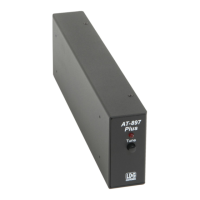PAGE 12
OPERATION
Power-up
The AT-897Plus is powered by the transceiver over the CAT interface cable. When the
transceiver is turned on, the AT-897Plus powers up. At this time, the AT-897Plus checks the
connection to the transceiver. If this check fails, the Status LED will blink continuously.
Possible causes for failure are an improperly seated CAT cable, a damaged CAT cable, incorrect
CAT baud rate setting, or plugging the CAT cable into a radio other than an FT-897 or FT-897D.
Basic Tuning Operation
The AT-897Plus is operated from the front panel TUNE button on the AT-897Plus. Two
types of tuning cycles are available; a memory tuning cycle and a full tuning cycle.
The memory tuning cycle attempts to tune quickly based on having previously tuned on the
present frequency selection. If the tuner previously was successful in tuning on the currently
selected frequency, the settings for that match will be loaded into the tuner relays, and checked to
see that an acceptable SWR match is found.
A full tuning cycle “starts from scratch” and begins a fixed tuning sequence where the AT-
897Plus rapidly tries varying combinations of inductance and capacitance values, and then
zeroes-in on the best match possible. When the tuning cycle is complete, if an acceptable match
was found, the inductance and capacitance settings are saved in a memory associated with the
selected frequency, so that they may be recalled quickly in the future via a memory tuning cycle.
In this manner, the AT-897Plus “learns”; the longer you use it, the more closely it adapts
itself to the bands and frequencies used. Most users will probably use memory tuning most of the
time; it takes advantage of any saved tuning settings, but automatically defaults to a full tuning
cycle if no stored data is available.
In both cases, at the end of the tuning cycle, the carrier is held for 1.5 seconds after tuning is
complete, so that the final SWR may be read on the transceiver’s internal SWR meter or another
inline SWR meter, and the front panel LED will indicate the status of the tuning cycle.
The tuner may also be placed in “bypass” mode where it is electrically removed from the
antenna system.
Although the FT-897 is designed to transmit and receive on all HF bands plus 6 meters, 2
meters and 70 centimeters, the AT-897Plus is designed only to work on HF and 6 meters. In
addition, the FT-897 transceiver transmits UHF and VHF on a different antenna jack than the
jack used for HF and 6 meters. For this reason, the AT-897Plus’s built-in software asks the
transceiver for its operating frequency before beginning a tuning cycle, and will not allow a
tuning cycle to begin if the radio is set above 60 MHz. This protects both the tuner and the radio!

